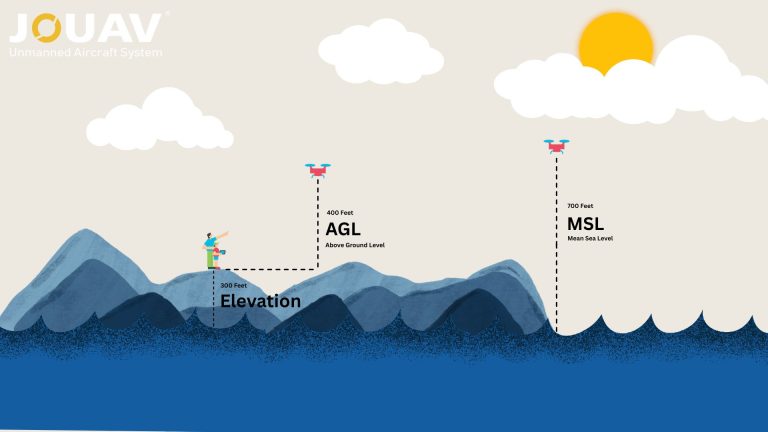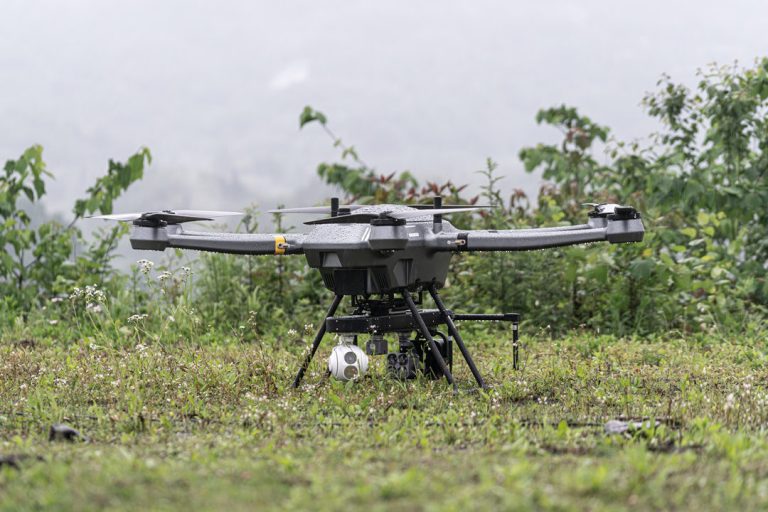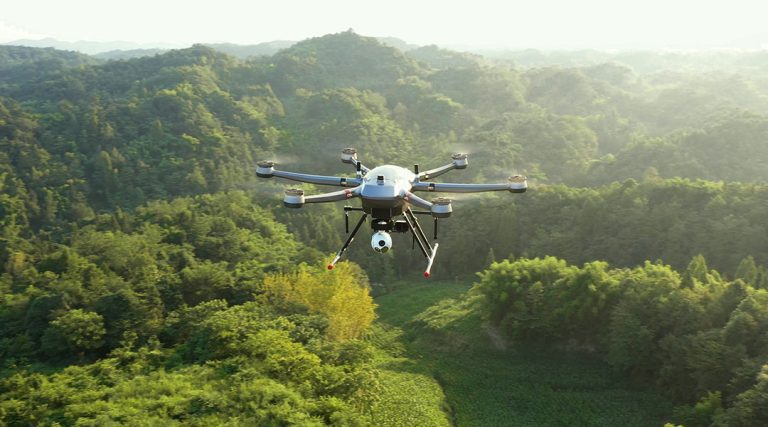The Ultimate Guide to Heavy Lift Drone Motors
Heavy lift drones boast a distinctive airborne capability, allowing them to effortlessly carry hefty payloads beyond the reach of conventional drones.
These ultra-large drones, with a weight capacity of up to 500 kg, excel in missions that demand transporting sizable loads—whether it's high-quality LiDAR, large sensors, or handling bulk cargo transportation.
The prowess of heavy lift drones largely hinges on a crucial component— the electric motors.
Whether you're an engineer immersed in drone technology or simply an enthusiast eager to explore the intricacies of heavy lift drone motors, you've landed in the right spot.
This article aims to provide an in-depth overview, covering the definition, types, and critical parameters of large drone motors. We'll also guide you on selecting the right motor for your specific needs.
Let's get started!
What is a Heavy Lift Drone Motor?
A heavy lift drone motor refers to the propulsion system used in drones designed for lifting heavy payloads.
These motors are typically more powerful and robust compared to those used in standard consumer drones, as they need to provide sufficient thrust to carry substantial weights.
Heavy lift drones are commonly used in various industries such as agriculture, construction, cinematography, and logistics, where the ability to transport sizable payloads is crucial.
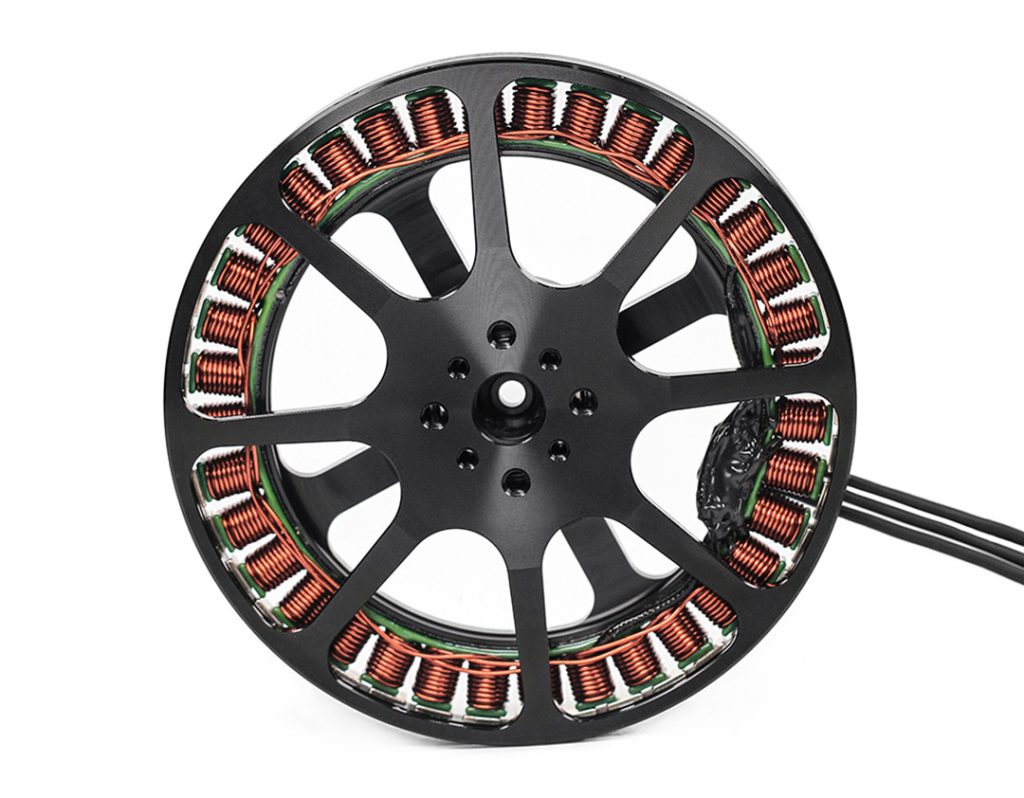
Brushless motors for PH-20 heavy lift multi-rotor UAVs
What Types of Motors are Used in Heavy Lift Drones?
Heavy lift drones commonly feature high-powered brushless motors, designed to deliver substantial thrust and lifting capacity for handling hefty payloads.
Take the PH-20 heavy-lift multirotor drone, equipped with a robust combination of bus ESC, a high-efficiency brushless motor, and a high-performance propeller. Crafted for power and efficiency, the PH-20 excels in challenging conditions, accommodating up to 10kg loads with an impressive endurance of up to 70 minutes.
Brushless DC Motors
Motors used in heavy lift drones, particularly those designed for large payloads, commonly leverage electric brushless DC motors. These motors are preferred over brushed motors due to their higher efficiency. In a brushless motor, the transfer of current from the commutator to the rotor occurs through non-contact methods, reducing energy losses associated with friction.
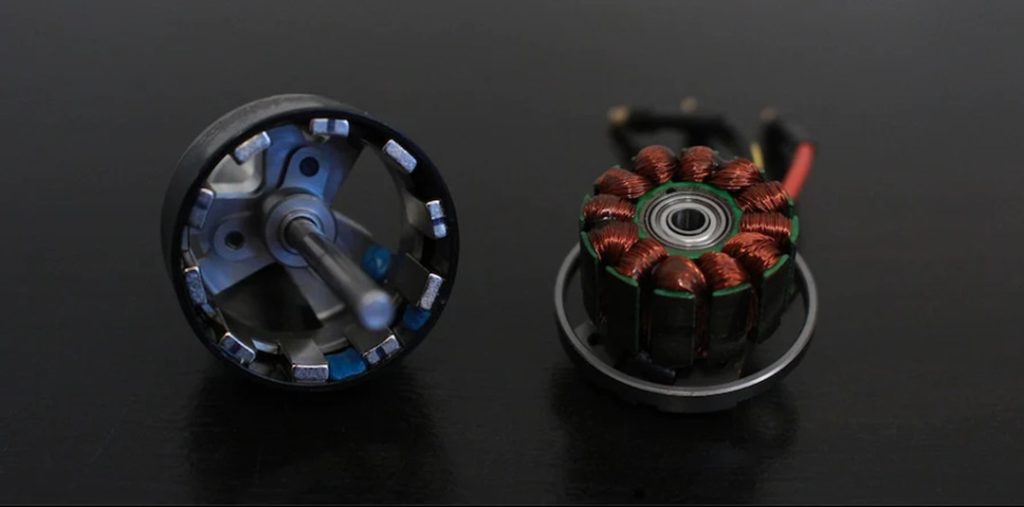
Rotor and Stator of an Outrunner Electric Motor. Source from tytorobotics.com
Key features and enhancements:
1. Integrated Centrifugal Fans: Some high-thrust motors incorporate integrated centrifugal fans to enhance cooling. Efficient cooling is crucial to prevent overheating during prolonged heavy lift operations.
2. High-Temperature Solid Core Copper Windings: The use of high-temperature solid core copper windings contributes to the motor's ability to handle elevated temperatures, which can be a concern during demanding drone operations.
3. Angular-Contact and Radial-Contact Ball Bearings: Motors designed for heavy lift applications may include angular-contact and radial-contact ball bearings. These bearings improve the overall durability and efficiency of the motor.
Brushless heavy-lift drone motors often adopt an "outrunner" design. In this configuration, the rotor rotates outside the stator, as opposed to within it. This design choice increases the torque generated by extending the application diameter. The larger diameter over which forces are applied results in greater torque, making these motors well-suited for heavy lift requirements.
Counter-Rotating Drone Motors
In addition to brushless motors, some heavy-lift drones incorporate a unique counter-rotating motor setup to further enhance efficiency.
Key elements of counter-rotating motors:
1. Slip Ring Mechanism: The counter-rotating motor setup employs a slip ring mechanism. This mechanism allows the capture of energy from both the active and reactive forces generated by the spinning motor. Slip Ring Mechanism: The counter-rotating motor setup employs a slip ring mechanism. This mechanism allows the capture of energy from both the active and reactive forces generated by the spinning motor.
2. Energy Harnessing: The energy from the reactive counter-force, typically absorbed by the non-moving stator and the body of the UAV, is harnessed. This harvested energy is then redirected to drive a counter-rotating propeller on the same motor.
The counter-rotating setup results in greater overall efficiency compared to standard motors. By effectively utilizing both the active and reactive forces, these motors can contribute to improved thrust and lift capabilities, making them particularly suitable for heavy-lift drone applications where maximizing efficiency is crucial.
What to Consider When Choosing the Best Heavy Lift Drone Motors?
Choosing the right motors for a heavy lift drone is a critical decision that directly impacts the drone's performance, stability, and efficiency. Here are key considerations to keep in mind:
Drone Weight & Frame
To begin building a drone, start by calculating its weight, factoring in components such as the frame, flight controller, ESCs, motors, propellers, battery, camera, and antenna.
Add a 10-20% buffer to account for potential inaccuracies or future modifications.
Once you have the estimated drone weight, determine the frame size.
Ideally, the frame should accommodate a maximum propeller size equal to one-third of its dimensions.
This proportionality optimizes aerodynamic performance, striking a balance between lift and stability for efficient flight.
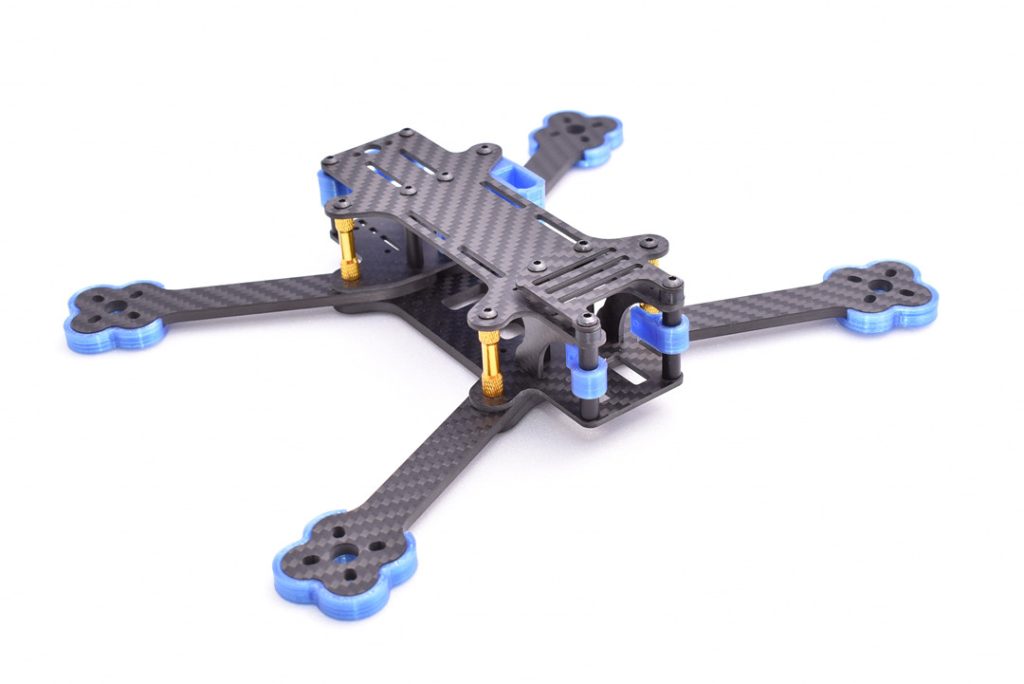
Drone frame. Source from unsplash.com
Thrust to Weight Ratio
Once you have determined the estimated weight of your drone and selected an appropriate frame size, the next crucial step in the design process is to establish the thrust requirements.
A fundamental guideline to follow is that the combined maximum thrust generated by all the motors should be at least double the weight of the drone.
For instance, if your drone weighs 1 kilogram, the collective thrust from all the motors should be a minimum of 2 kilograms. In the case of a quadcopter, this translates to each motor producing a maximum thrust of at least 500 grams.
This threshold ensures that the drone has the lifting capacity required for takeoff.
Ideally, for standard drones, a thrust-to-weight ratio of 3:1 or 4:1 is recommended. This ratio ensures that the drone not only lifts off effectively but also possesses the maneuverability needed for smooth and controlled flight.
Additionally, it allows the drone to accommodate extra payloads without compromising its overall performance.
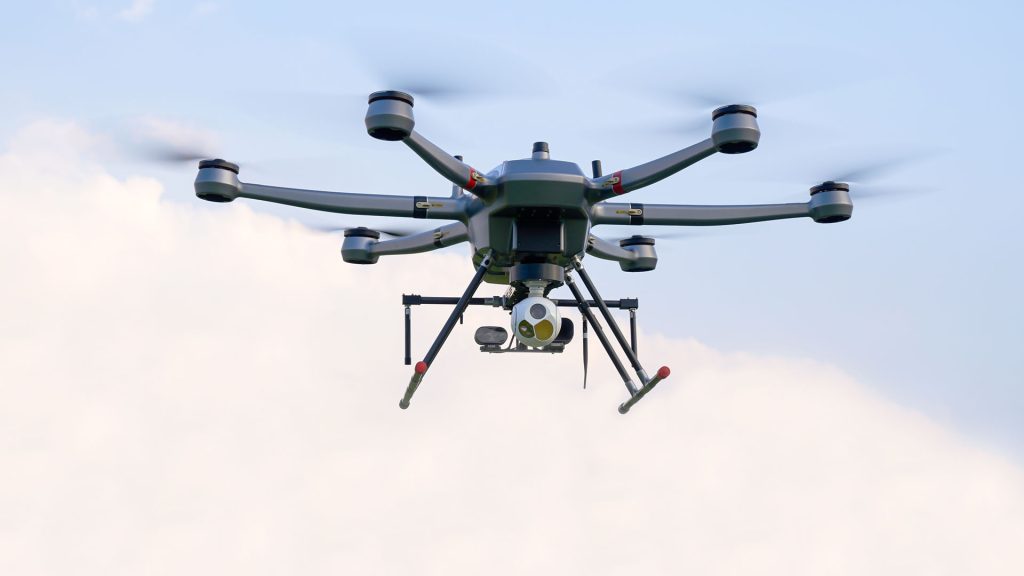
PH-20 with MG-130E gimbal camera for aerial surveillance
Motor Size
A drone motor, whether brushed or brushless, consists of a stator with metal coils and a motor bell housing permanent magnets.
The stator's width and height, denoted by XXYY, determine the motor size. Larger motors offer more torque and thrust but are less responsive and heavier.
The metal coils, enameled for insulation, form the stator and generate a temporary magnetic field when an electric current flows through them.
The motor bell, attached to the inner side of the motor, protects the permanent magnets and coils. The motor shaft transfers torque from the motor to the propellers when the changing magnetic fields cause rotation.
Choosing the right motor size is critical. Larger motors provide more thrust but sacrifice responsiveness and add weight. For multi-copters, determining the required thrust from each motor based on a desired thrust-to-weight ratio is essential.
This ensures optimal performance by listing motors meeting the thrust requirement and selecting the smallest ones that fulfill these specifications, balancing power, responsiveness, and weight for efficient drone functionality.
Wider Motors
When selecting BLDC motors for drones, their dimensions—specifically, stator width and height—play a crucial role in performance.
Wider stator motors have greater inertia, making them less responsive to speed changes but offering effective cooling due to increased surface area. Additionally, their design allows for larger bearings, enhancing durability, efficiency, and stability.
Narrow stator motors are more responsive but may face challenges in cooling due to their compact design.
The choice between wide and narrow stators hinges on the drone's purpose. For drones lifting payloads, where responsiveness is less critical, wider motors are preferred.
Payload drones require careful piloting, making the sacrifice in responsiveness acceptable for the benefits of cooling efficiency and motor robustness.
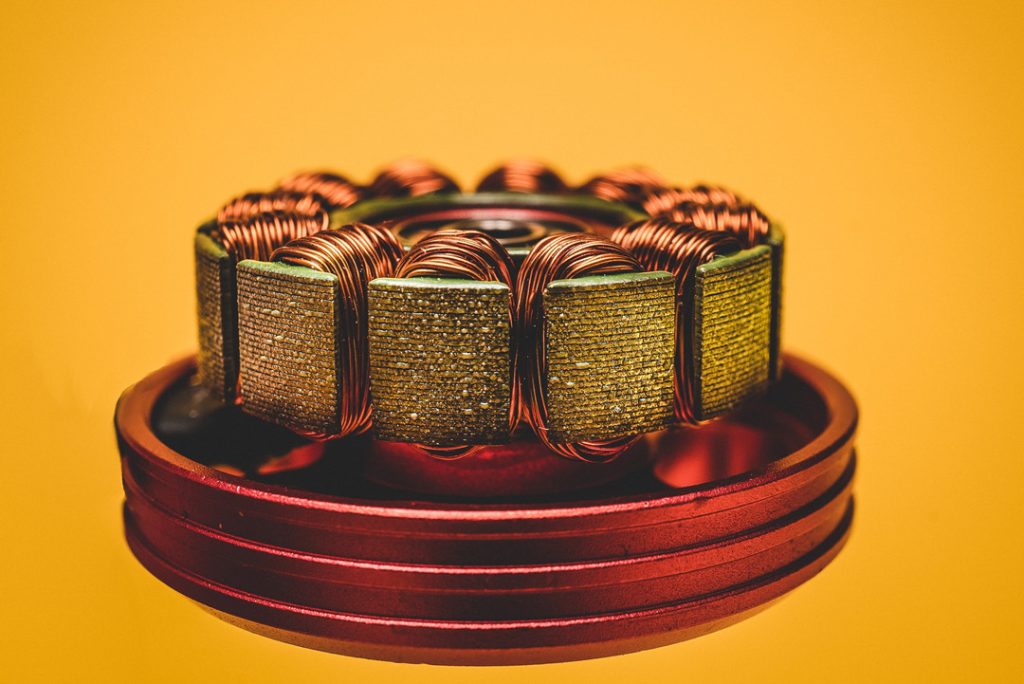
An electric motor with all its copper windings. Source from unsplash.com
KV Rating
The next critical step is to consider the relationship between KV ratings and propeller selection for optimal drone performance.
Higher KV ratings indicate more revolutions per minute (RPM) when one volt is applied to an unloaded motor.
Motors with higher KV ratings typically have shorter windings and lower internal resistance, but they are prone to early heating.
This heating issue is more evident in taller motors with higher KV ratings due to their greater rotational speeds and thrust generation.
The conventional strategy involves pairing motors with higher KV ratings with lighter propellers and motors with lower KV ratings with heavier propellers.
This approach ensures a balance between motor characteristics and propeller load.
When a high KV rating motor is combined with a heavy propeller, it attempts to rotate the propeller at maximum speed, requiring more torque and drawing increased current.
This situation could potentially damage the Electronic Speed Controller (ESC) or MOSFETs.
Conversely, a low KV rating motor paired with a lighter propeller may struggle to produce sufficient thrust.
For those opting for wider motors to enhance maneuverability at slower speeds, a low KV rating motor with heavier propellers is recommended.
Conversely, for drones focused on rapid racing without carrying a payload, choosing a taller motor with a high KV rating and lighter propellers is more suitable.
It's crucial to note that the KV rating is a manufacturer-provided estimate, and actual motor RPM may vary due to factors like air resistance.
Whether selecting a low KV rating motor with a heavier propeller or a high KV rating motor with a lighter propeller, the key is to achieve the desired thrust-to-weight ratio.
Motor Torque
The torque a motor produces relies on factors like stator volume, magnet types, coil quality, and construction details (e.g., pole count, insulation gap).
Greater stator volume generally means a heavier motor, but if two motors share the same stator volume, the lighter one is preferred.
Motor torque affects responsiveness to pilot input.
Excessive torque can lead to jerky drone movements, causing difficulties in control and potential damage to the ESC unit due to voltage or current surges.
Choosing a lighter motor strikes a balance between power and control, mitigating these issues.
For optimal performance, selecting motors tailored to specific needs is crucial.
In scenarios where slow, steady flight with a payload is required, opting for motors with lower torque and RPM is recommended.
This ensures a precise and controlled flight experience while safeguarding electronic components.
KV vs. Torque Constant
The torque constant of a drone motor dictates the current required to generate torque.
Although not theoretically linked, practical observations reveal a trend: higher KV rating motors generally have higher torque constants, while lower KV rating motors have lower torque constants.
In practice, this means high KV rating motors draw more current to achieve a given torque, impacting energy efficiency.
High KV rating motors are less power-efficient than their low KV rating counterparts due to increased current consumption.
Optimal power efficiency requires choosing a KV rating that balances performance and efficiency, preventing excessive torque constant that hampers overall effectiveness.
Utilizing a motor with an excessively high torque constant poses risks, including damage to the Electronic Speed Controller (ESC) and motor heating issues.
Long-term consequences include reduced battery lifespan and increased wear on wires, motors, and MOSFETs (Metal-Oxide-Semiconductor Field-Effect Transistors).
Current Voltage & Efficiency
Selecting a suitable Brushless DC (BLDC) motor for a drone hinges on careful evaluation of voltage and current ratings.
The relationship between motor voltage and current draw is crucial—higher motor voltage typically results in increased current consumption from the battery during operation.
To determine the maximum current drawn by the motor, calculate this value when the motor operates at its highest voltage, generating maximum thrust.
This calculation is pivotal for selecting an Electronic Speed Controller (ESC) with an appropriate current rating.
When choosing an ESC, ensure that its current rating surpasses the maximum current drawn by the motor.
While the continuous current rating of the ESC is important, it does not necessarily need to exceed the maximum motor current.
However, it's imperative that the burst current rating is greater than the maximum motor current to ensure reliable and safe operation.
Ideally, opting for an ESC with a continuous current rating higher than the maximum motor current is advantageous.
This surplus capacity provides an additional safety margin, contributing to the longevity and reliability of the drone's propulsion system.
It ensures the ESC can handle unexpected spikes in current demand, preventing overheating and potential damage.
N & P in Motor
Drone motors are labeled with N & P ratings, such as 12N15P, indicating the number of poles in the motor stator and the permanent magnets.
Fewer poles, as seen in 12N15P, result in higher torque, while more poles contribute to smoother operation due to a uniform magnetic field.
As drone motors are three-phase, pole numbers are always multiples of 3. For 22XX and 23XX BLDC motors, the common configuration is 12N15P.
It's important to note that the number of poles and magnets doesn't directly impact motor performance but is essential for configuring flight controllers, like enabling RPM filters.
Understanding these ratings ensures optimal performance and responsiveness in drone systems.
Mounting Pattern
Drone motors, specifically the 22XX, 23XX, and 24XX series, feature versatile mounting patterns of 16x16mm or 16x19mm.
To ensure compatibility with various frames, a drone frame must support both of these patterns.
For the attachment of these motors, M3 screws are the standard choice.
The key consideration here is the length of these screws, which should exceed the thickness of the drone arm by 2mm.
For example, if the drone arm is 5mm thick, the recommended length for the M3 screws is 7mm.
This precision in screw length is crucial for a secure and stable connection between the motors and the frame.
Following these guidelines ensures a reliable and robust assembly, contributing to the overall performance and structural integrity of the drone.
Motor Winding
The choice of motor winding significantly influences motor performance.
Thick wires handle higher currents but reduce the electromagnetic field, impacting torque.
Thin wires excel in creating strong electromagnetic fields and torque but struggle with high current draw due to increased internal resistance.
To navigate this balance, manufacturers often opt for thick copper wires with more windings.
This combination maintains current resilience while enhancing the stator's electromagnetic field, resulting in increased torque.
Motor windings come in two options: single-stranded and multi-stranded.
Single-stranded uses thick wires for larger current draw, suitable for high-voltage battery packs.
Multi-stranded, with three thinner strands, produces powerful electromagnetic fields and torque but faces a risk of damage from high current draw, leading to a lower KV rating.
Motor Bearing
The motor's bearing size directly influences its durability and operational smoothness.
Larger bearings enhance durability by distributing loads and dissipating heat effectively, making them suitable for heavy-duty applications.
On the other hand, smaller bearings contribute to stability and smooth operation, ideal for precision machinery.
The inner diameter of the bearing determines the motor shaft size, emphasizing the interconnected nature of motor components.
Some manufacturers promote motors with ceramic bearings for their smooth performance, though they may be more prone to breakage compared to steel bearings.
Motor Movements
Drone motors rotate in opposite directions for stability during flight. If all motors spun the same way, the drone would struggle to lift off and maintain control.
To achieve balance, motors mounted diagonally across from each other rotate in opposite directions—one clockwise, the other counter-clockwise.
This configuration counters torque, ensuring a stable and controlled flight, a crucial design principle adopted in multirotor drones for optimal performance.
Motor Connections
Drone motors, categorized as brushed DC or brushless DC, dictate the rotation direction — clockwise or counterclockwise.
Brushed motors have two wires, while brushless ones have three, all connecting to the Electronic Speed Controller (ESC), which, in turn, links to the flight controller.
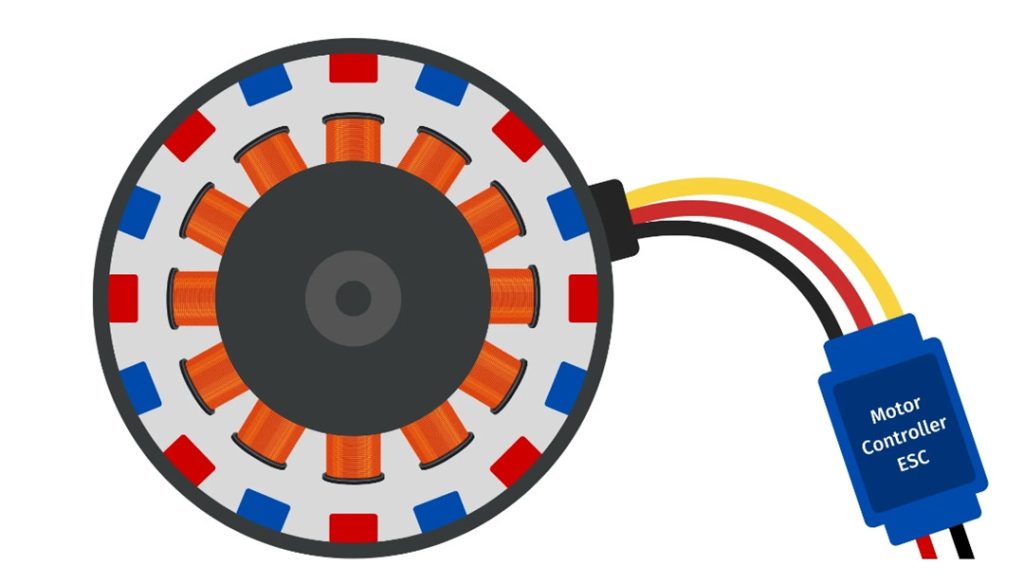
Brushless DC motor with ESC. Source from tytorobotics.com
Swapping any two wires connected to the ESC reverses motor rotation.
This simple adjustment is instrumental in tailoring the drone's behavior to specific flight conditions or preferences.
Additionally, the flight controller, responsible for stability and orientation, can be programmed to further modify motor behavior, providing a centralized and efficient means of control.
Brushless DC Motor vs. AC Motor vs. Brushed Motor
The choice of motor technology for heavy lift drones plays a pivotal role in determining performance, efficiency, and overall reliability. Each type of motor has its advantages and disadvantages. Let's briefly discuss each type:
Motor Construction
Brushed DC motors rely on a mechanical system involving brushes and a commutator to transfer current, whereas AC and brushless DC motors utilize electronic mechanisms.
Brushed motors have a wound armature connected to a central permanent magnet, and as the brushes contact the commutator, current flows through the armature coils.
In contrast, AC and BLDC motors pass current through the stator, eliminating the need for mechanical brushes.
AC induction motors induce rotation in the rotor through a rotating magnetic field in the stator, while BLDC motors, with permanent magnets directly bonded to the rotor, generate motion as the stator produces electromagnetic poles.
The construction differences contribute to varied performance characteristics.
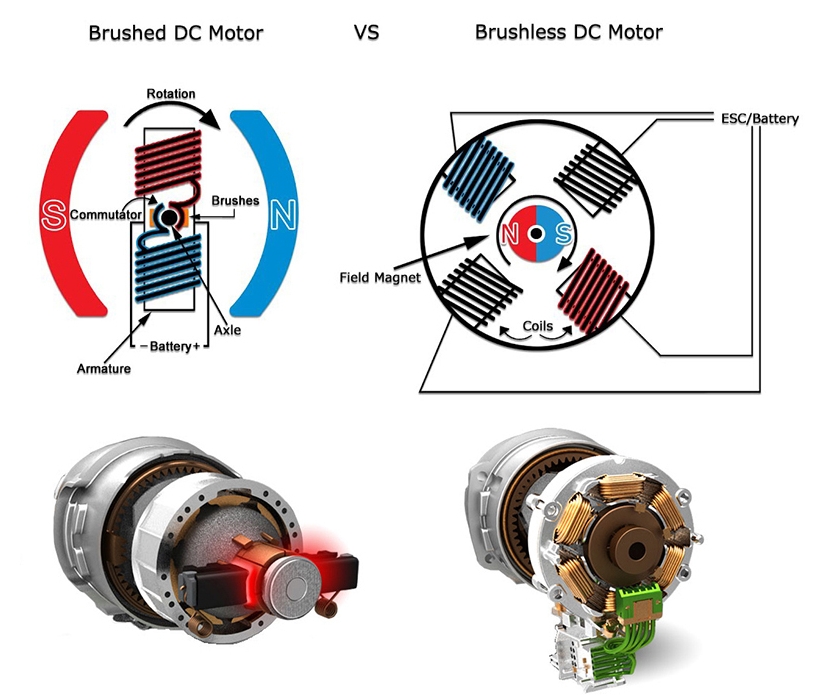
Brushed vs. brushless DC motor. Source from ato.com
Efficiency
Efficiency is a critical factor in motor selection. BLDC motors generally outperform both AC and brushed DC motors in terms of energy efficiency.
DC motors, particularly brushed ones, benefit from the use of permanent magnets, avoiding energy expenditure on creating an electromagnet, a process inherent in AC motors.
The absence of brushes in BLDC motors reduces friction, enhancing efficiency, especially in low-load conditions.
The smaller size of BLDC motors further contributes to increased efficiency, as they dissipate less heat.
Service and Maintenance
In heavy-lift drone applications, service life and maintenance requirements are crucial considerations.
Brushed motors, while larger in size, have a shorter service life due to wear on carbon or graphite brushes.
Regular maintenance and replacement are necessary, introducing potential points of failure.
In contrast, brushless motors exhibit longer service lives, cleanliness, and quieter operation since they lack components prone to wear and friction.
Speed Stability
BLDC motors offer superior speed stability, thanks to the integration of Hall-effect sensors.
These sensors detect changes in polarity as the rotor spins, allowing precise speed control.
The information gathered is then used by the drive circuit to adjust the switching sequence, ensuring stable and accurate speed regulation.
High-Speed Operation
Brushed and brushless DC systems excel in providing flat torque across a wide speed range, making them suitable for heavy-lift drone applications.
AC motors, on the other hand, often experience a loss of torque as speed increases.
BLDC packages, such as those offered by Oriental Motor, provide a versatile range of speed control, accommodating speeds as low as 3 rpm and as high as 4,000 rpm.
For heavy lift drones, brushless DC (BLDC) motors have emerged as a popular and preferred choice, primarily attributed to their exceptional combination of high efficiency, favorable power-to-weight ratio, and precise control.
Inrunner vs. Outrunner Motors
Inrunner and outrunner motors are types of brushless DC (BLDC) motors.
An outrunner motor, categorized as a Permanent Magnet Synchronous Motor (PMSM) torque motor, stands out due to its unique design.
In contrast to inrunner motors, outrunners have magnets affixed to a ring or sleeve on the outside of the stator coils, resulting in a rotating ring or sleeve rather than a shaft.
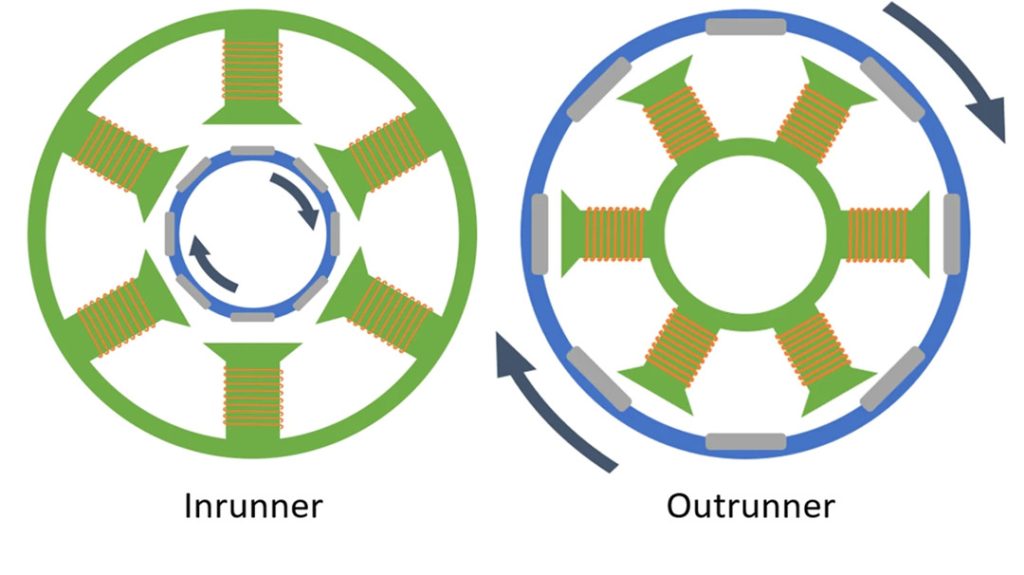
Inrunnder motor vs. outrunner motor. Source from tytorobotics.com
The paramount advantage of outrunner motors, particularly in the context of heavy lift applications, lies in their ability to generate more torque within the same build volume compared to inrunner motors.
This is attributed to the larger air gap surface area in outrunners, facilitating a more substantial passage for electromagnetic field lines from the rotor to the stator.
The increased surface area leads to a higher electromechanical force and, consequently, greater torque.
Additionally, outrunner motors exhibit a longer torque arm, generated from the force being exerted further from the center of rotation.
This extended torque arm, combined with the augmented air gap surface area, enables outrunner motors to achieve significantly higher torque levels.
In scenarios where substantial torque is essential within constrained build volumes, outrunner motors prove to be the superior choice.
In contrast, inrunner motors, with the rotor located on the inside of the stator, often grapple with lower torque output.
To address this limitation, inrunner motors may incorporate transmissions or gearboxes.
However, this solution introduces complexities, including increased build volume, elevated mechanical losses, higher maintenance needs, and susceptibility to contamination.
For heavy lift drones operating under stringent build volume constraints while requiring substantial torque, outrunner motors emerge as the preferred option.
Their innate capacity to deliver higher torque levels, coupled with a simpler design, positions outrunner motors as the optimal choice for achieving exceptional performance and efficiency in heavy lift drone applications.
How Much Does Heavy Lift Drone Cost?
Ever wondered about the cost of heavy lift drone motors? Heavy lift drone motors can cost between $200 and $1,000. The price range varies, and understanding the factors influencing these costs is crucial for informed decisions.
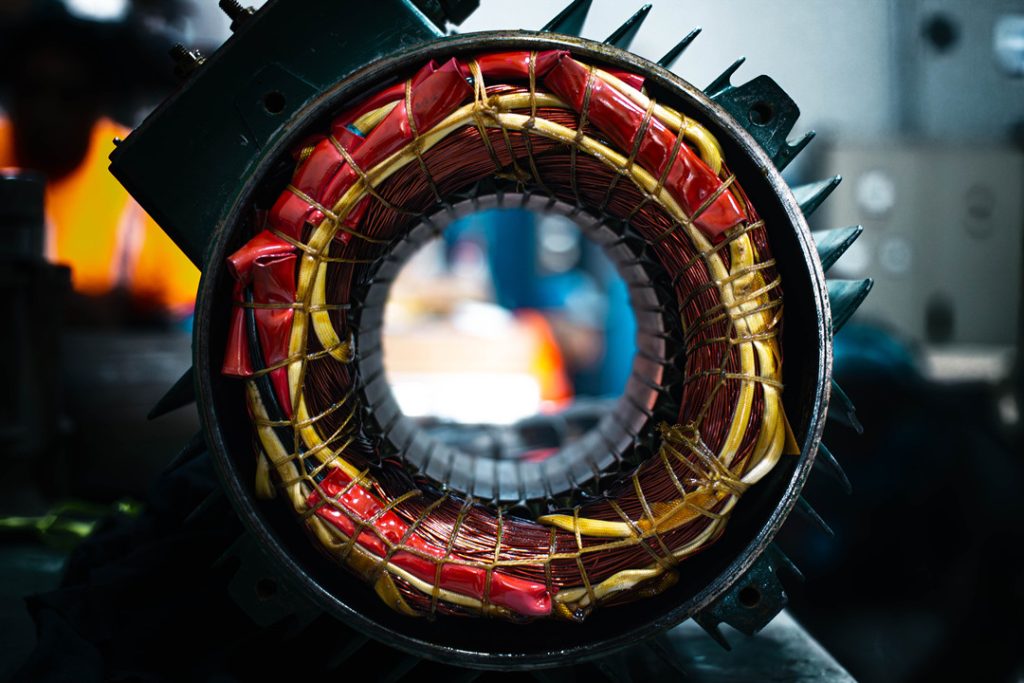
Electric motor. Source from unsplash.com
Motor Type
As mentioned, the type of motor significantly influences the price range.
Brushed DC motors generally fall in the $200 to $500 range, brushless DC motors typically range from $300 to $1000, and AC motors are priced between $200 and $800.
The differences in construction, efficiency, and complexity contribute to the varying costs among these motor types.
Power Rating
The power rating of a motor, often measured in watts or horsepower, directly impacts its price.
Higher power-rated motors, capable of handling heavier payloads and providing greater thrust, tend to be more expensive.
For heavy lift drones, where power is a critical factor, motors with higher power ratings are often preferred, albeit at a higher cost.
Build Quality and Materials
The price of motors is influenced by the materials they're made of and how well they're put together.
If a motor is crafted using top-notch materials like premium metals or advanced composites, it's likely to be pricier.
Motors built to handle diverse environments might need special materials to endure challenges like moisture, extreme temperatures, or corrosive conditions.
This aspect becomes crucial in heavy lift drones. For these drones, having sturdy and dependable components is a must for ensuring safe and effective performance.
Technology and Features
Advanced technologies and additional features can contribute to increased motor costs.
For example, motors equipped with advanced control systems, feedback mechanisms, and sensors for precise control may be priced higher.
Innovations in motor design, such as those enhancing efficiency and reducing heat generation, can also influence the cost.
Customization Options
Some motor manufacturers provide customization options, allowing customers to tailor motors to specific requirements.
Customized features, such as shaft configurations, mounting options, or special coatings, can contribute to higher prices.
Customization is particularly relevant in heavy lift drone applications, where specific payload and operational requirements may necessitate unique motor specifications.
FAQ
What Are the Different Motors on a Drone?
Drones typically have multiple motors that serve various purposes. These motors are responsible for generating thrust, controlling the drone's movement, and ensuring stability during flight.
The main types of motors on a drone include those for lift, propulsion, and control. The lift motors provide the upward force needed for takeoff and hovering, while the propulsion motors drive the drone forward.
Control motors adjust the orientation and stability of the drone by varying the speeds of individual rotors.
Each motor plays a specific role in achieving controlled and stable flight, allowing the drone to respond to pilot commands or automated flight systems.
What Types of Electric Motors are Used in Drones?
Drones typically employ either brushless or brushed motors.
Brushless motors are commonly found in larger, high-performance models like racing and cinematography drones, offering efficiency, longevity, and a favorable power-to-weight ratio.
In contrast, brushed motors are simpler and more cost-effective, often used in smaller drones, toy-grade models, and micro drones.
What Is a Good KV for a Drone Motor?
As a general guideline, drone motors can have KV ratings ranging from around 500 to 3000 KV or even higher. Lower KV motors are often used for larger drones carrying heavier payloads, while higher KV motors are suitable for smaller, lighter drones.
How Much RPM Motor Is Required for a Drone?
The required RPM (Revolutions Per Minute) for a drone motor can vary based on several factors, including the size and weight of the drone, the type of propellers used, the desired flight characteristics, and the overall design of the drone.
For small toy drones, the motor RPM might be in the range of 10,000 to 15,000 RPM, while larger and more professional drones may have motors with RPM values exceeding 20,000 RPM.
What is a High Efficiency Brushless Motor?
A high-efficiency brushless motor is designed to minimize energy loss and heat generation while providing maximum power output. These motors often use quality materials and advanced engineering for optimal performance.
What is the Power Output of a Brushless Motor?
The power range for BLDC motors can be approximately 30 to 3000 watts. However, it's important to note that there can be exceptions, and some motors may fall outside this range.
What is the Maximum Speed of a Brushless Motor?
While some high-performance brushless motors can indeed achieve speeds of 100,000 rpm or more, it's essential to note that the practical limits may be influenced by factors such as heat generation, mechanical stress on the components, and the capabilities of the materials used.
Motors designed for specific applications, like those used in drones or certain industrial machines, may be optimized for higher speeds.
How Fast is a 3000W Brushless Motor?
A 3000W brushless motor can have a rated speed of 4900 rpm/min and a maximum speed of 6700 rpm/min.
What are the Electric Motors in a Quadcopter for?
The electric motors in a quadcopter convert electrical energy into mechanical energy. This energy is used to spin the propellers, which generate the thrust necessary for lift and propulsion.
What is the Power Output of an Electric Motor that Lifts?
The power output of an electric motor that lifts depends on the weight and height it's lifting, and the time it takes to do so. The power output can be calculated using the following formula:
For example, the power output of an electric motor that lifts a 2 kg block 15 meters in 6 seconds is 49 watts.
Power =Work/Time
The mechanical power of an electric motor is defined as the speed times the torque. Mechanical power is usually measured in kilowatts (kW) or horsepower (hp). One watt is equal to one joule per second or one Newton-Meter per second.



